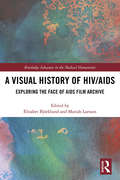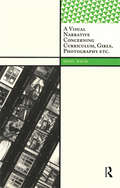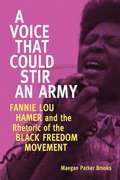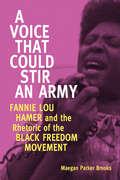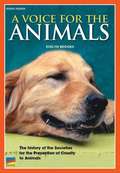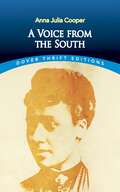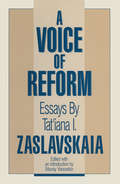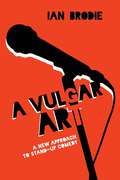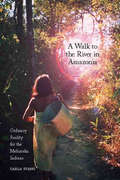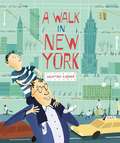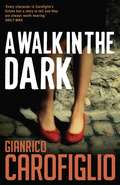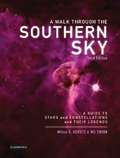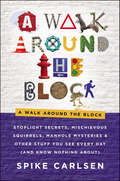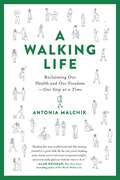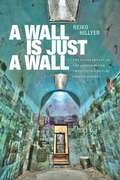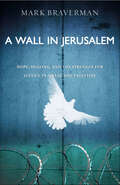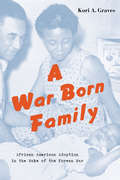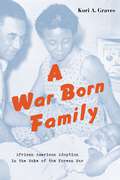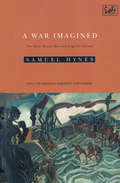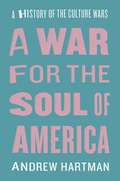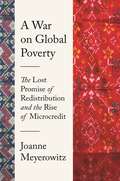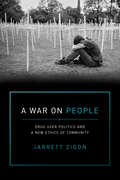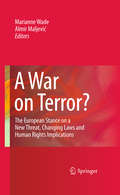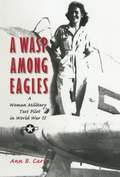- Table View
- List View
A Visual History of HIV/AIDS: Exploring The Face of AIDS film archive (Routledge Advances in the Medical Humanities)
by Elisabet Björklund Mariah LarssonThe Face of AIDS film archive at Karolinska Institutet, Sweden, consists of more than 700 hours of unedited and edited footage, shot over a period of more than thirty years and all over the world by filmmaker and journalist Staffan Hildebrand. The material documents the HIV/AIDS pandemic and includes scenes from conferences and rallies, and interviews with activists, physicians, people with the infection, and researchers. It represents a global historical development from the early years of the AIDS crisis to a situation in which it is possible to live a normal life with the HIV virus. This volume brings together a range of academic perspectives – from media and film studies, medical history, gender studies, history, and cultural studies – to bear on the archive, shedding light on memories, discourses, trauma, and activism. Using a medical humanities framework, the editors explore the influence of historical representations of HIV/AIDS and stigma in a world where antiretroviral treatment has fundamentally altered the conditions under which many people diagnosed with HIV live. Organized into four sections, this book begins by introducing the archive and its role, setting it in a global context. The first part looks at methodological, legal and ethical issues around archiving memories of the present which are then used to construct histories of the past; something that can be particularly controversial when dealing with a socially stigmatized epidemic such as HIV/AIDS. The second section is devoted to analyses of particular films from the archive, looking at the portrayal of people living with HIV/AIDS, the narrative of HIV as a chronic illness and the contemporary context of particular films. The third section looks at how stigma and trauma are negotiated in the material in the Face of AIDS film archive, discussing ideas about suffering and culpability. The final section contributes perspectives on and by the filmmaker as activist and auteur. This interdisciplinary collection is placed at the intersection of medical humanities, sexuality studies and film and media studies, continuing a tradition of studies on the cultural and social understandings of HIV/AIDS.
A Visual Narrative Concerning Curriculum, Girls, Photography Etc. (International Institute for Qualitative Methodology Series)
by Hedy BachThis multi-genre book is a deconstructive project that reveals the elisions, blind spots, and loci within the complex web of daily life of four schoolgirls. The girls, who attend school and actively connect their learning to the study of art, drama, ballet and music programs in and out of school, visually documented their lives both inside and outside of classrooms, using disposable cameras to create 80 to 120 photographs. One-on-one conversations with them about their images were taped and transcribed, and the analysis of these images and texts provides a description of the “evaded curriculum” within adolescent life. The research exposes pain, reveals desire and pleasure, and expresses the intensity of joy in making and creating schoolgirl culture.
A Voice That Could Stir an Army: Fannie Lou Hamer and the Rhetoric of the Black Freedom Movement (Race, Rhetoric, and Media Series)
by Maegan Parker BrooksA sharecropper, a warrior, and a truth-telling prophet, Fannie Lou Hamer (1917-1977) stands as a powerful symbol not only of the 1960s black freedom movement, but also of the enduring human struggle against oppression. A Voice That Could Stir an Army is a rhetorical biography that tells the story of Hamer's life by focusing on how she employed symbols-- images, words, and even material objects such as the ballot, food, and clothing--to construct persuasive public personae, to influence audiences, and to effect social change. <p><p> Drawing upon dozens of newly recovered Hamer texts and recent interviews with Hamer's friends, family, and fellow activists, Maegan Parker Brooks moves chronologically through Hamer's life. Brooks recounts Hamer's early influences, her intersection with the black freedom movement, and her rise to prominence at the 1964 Democratic National Convention. Brooks also considers Hamer's lesser-known contributions to the fight against poverty and to feminist politics before analyzing how Hamer is remembered posthumously. The book concludes by emphasizing what remains rhetorical about Hamer's biography, using the 2012 statue and museum dedication in Hamer's hometown of Ruleville, Mississippi, to examine the larger social, political, and historiographical implications of her legacy. <p> The sustained consideration of Hamer's wide-ranging use of symbols and the reconstruction of her legacy provided within the pages of A Voice That Could Stir an Army enrich understanding of this key historical figure. This book also demonstrates how rhetorical analysis complements historical reconstruction to explain the dynamics of how social movements actually operate.
A Voice That Could Stir an Army: Fannie Lou Hamer and the Rhetoric of the Black Freedom Movement (Race, Rhetoric, and Media Series)
by Maegan Parker BrooksA sharecropper, a warrior, and a truth-telling prophet, Fannie Lou Hamer (1917–1977) stands as a powerful symbol not only of the 1960s black freedom movement, but also of the enduring human struggle against oppression. A Voice That Could Stir an Army is a rhetorical biography that tells the story of Hamer's life by focusing on how she employed symbols—images, words, and even material objects such as the ballot, food, and clothing—to construct persuasive public personae, to influence audiences, and to effect social change. Drawing upon dozens of newly recovered Hamer texts and recent interviews with Hamer's friends, family, and fellow activists, Maegan Parker Brooks moves chronologically through Hamer's life. Brooks recounts Hamer's early influences, her intersection with the black freedom movement, and her rise to prominence at the 1964 Democratic National Convention. Brooks also considers Hamer's lesser-known contributions to the fight against poverty and to feminist politics before analyzing how Hamer is remembered posthumously. The book concludes by emphasizing what remains rhetorical about Hamer's biography, using the 2012 statue and museum dedication in Hamer's hometown of Ruleville, Mississippi, to examine the larger social, political, and historiographical implications of her legacy. The sustained consideration of Hamer's wide-ranging use of symbols and the reconstruction of her legacy provided within the pages of A Voice That Could Stir an Army enrich understanding of this key historical figure. This book also demonstrates how rhetorical analysis complements historical reconstruction to explain the dynamics of how social movements actually operate.
A Voice but No Power: Organizing for Social Justice in Minneapolis
by David ForrestExamining the work of social justice groups in Minneapolis following the 2008 recession Since the Great Recession, even as protest and rebellion have occurred with growing frequency, many social justice organizers continue to displace as much as empower popular struggles for egalitarian and emancipatory change. In A Voice but No Power, David Forrest explains why this is the case and explores how these organizers might better reach their potential as advocates for the abolition of exploitation, discrimination, and other unjust conditions.Through an in-depth study of post-2008 Minneapolis—a center of progressive activism—Forrest argues that social justice organizers so often fall short of their potential largely because of challenges they face in building what he calls &“contentious identities,&” the public identities they use to represent their constituents and counteract stigmatizing images such as the &“welfare queen&” or &“the underclass.&” In the process of assembling, publicizing, and legitimating contentious identities, he shows, these organizers encounter a series of political hazards, each of which pushes them to make choices that weaken movements for equality and freedom. Forrest demonstrates that organizers can achieve better outcomes, however, by steadily working to remake their hazardous political terrain.The book&’s conclusion reflects on the 2020 uprising that followed the police killing of George Floyd, assessing what it means for the future of social justice activism. Ultimately, Forrest&’s detailed analysis contributes to leading theories about organizing and social movements and charts possibilities for further emboldening grassroots struggles for a fairer society.
A Voice for the Animals
by Nancy White Evelyn BrooksFind out about the importance of kindness while exploring the history of the Society for the Prevention of Cruelty to Animals.
A Voice from the South (Dover Thrift Editions)
by Janet Neary Anna Julia CooperA cornerstone of black feminist and political theory, this collection of essays focuses on racial progress and women's rights. A Voice from the South, written in 1892, is regarded as the first statement of black feminism. Despite their imprint of nineteenth-century social thought, these essays possess an urgent, modern tone, characterized by an emphasis on debate and a scintillating wit. Topics include the importance of women's education as well as African Americans' economic roles and their literary representation.A noted member of Washington, D. C.'s African American community, Anna Julia Cooper (1858 - 1964) rose to prominence as a leading scholar, educator, and activist at the end of the nineteenth century. Born into slavery, she was the fourth African American woman to earn a doctoral degree, receiving a PhD in history from the University of Paris-Sorbonne in 1924. This edition includes an informative Introduction to Cooper's life and work by Janet Neary.
A Voice of Reform: Essays
by Murray Yanowitch A. Schultz Tatiana I. ZaslavskaiaFirst Published in 1989. Routledge is an imprint of Taylor & Francis, an Informa company.
A Vulgar Art: A New Approach to Stand-Up Comedy (Folklore Studies in a Multicultural World Series)
by Ian BrodieIn A Vulgar Art, Ian Brodie uses a folkloristic approach to stand-up comedy, engaging the discipline's central method of studying interpersonal, artistic communication and performance. Because stand-up comedy is a rather broad category, people who study it often begin by relating it to something they recognize—“literature” or “theatre”; “editorial” or “morality”—and analyze it accordingly. A Vulgar Art begins with a more fundamental observation: someone is standing in front of a group of people, talking to them directly, and trying to make them laugh. So, this book takes the moment of performance as its focus, that stand-up comedy is a collaborative act between the comedian and the audience. Although the form of talk on the stage resembles talk among friends and intimates in social settings, stand-up comedy remains a profession. As such, it requires performance outside of the comedian's own community to gain larger and larger audiences. How do comedians recreate that atmosphere of intimacy in a roomful of strangers? This book regards everything from microphones to clothing and LPs to Twitter as strategies for bridging the spatial, temporal, and sociocultural distances between the performer and the audience.
A Walk To The River In Amazonia
by Carla StangOur lives are mostly composed of ordinary reality -- the flow of moment-to-moment existence -- and yet it has been largely overlooked as a subject in itself for anthropological study. In this work, the author achieves an understanding of this part of reality for the Mehinaku Indians, an Amazonian people, in two stages: first by observing various aspects of their experience and second by relating how these different facets come to play in a stream of ordinary consciousness, a walk to the river. In this way, abstract schemata such as 'cosmology,' 'sociality,' 'gender,' and the 'everyday' are understood as they are actually lived. This book contributes to the ethnography of the Amazon, specifically the Upper Xingu, with an approach that crosses disciplinary boundaries between anthropology, philosophy, and psychology. In doing so it attempts to comprehend what Malinowski called the 'imponderabilia of actual life.'
A Walk in New York
by Salvatore RubbinoA wide-eyed boy and his dad explore the Big Apple’s busy streets and towering views in this child-friendly tribute to an incomparable city. <P><P>New York City — the perfect place for a boy and his dad to spend the day! Follow them on their walk around Manhattan, from Grand Central Terminal to the top of the Empire State Building, from Greenwich Village to the Statue of Liberty, learning lots of facts and trivia along the way. In this unabashed ode to America’s biggest city, Salvatore Rubbino’s fresh, lively paintings and breezy text capture the delight of a young visitor experiencing the wonders of New York firsthand.
A Walk in the Dark
by Howard Curtis Gianrico CarofiglioWhen no lawyer accepts to represent Marina in her attempt to bring her boyfriend to trial for assault and battery, Guerrieri takes the case. No witnesses willing to testify and a hostile judge: just his kind of case. Doesn't hurt that he's attracted to Sister Maria, the young woman protecting Marina, who shares his love for martial arts.
A Walk through the Southern Sky
by Wil Tirion Milton D. HeifetzA Walk through the Southern Sky is a beautifully illustrated guide to the stars and constellations of the southern hemisphere. By following the simplified and easy-to-use starmaps, readers will be able to identify constellations with no equipment but normal sight and a clear night sky. This book provides clear instructions on how to determine star sizes and the distances between stars, allowing readers to move easily between constellations. The budding astronomer is introduced to the mystery and wonder of the southern sky as the myths and legends of its stars and constellations are wondrously retold. The third edition of this magical book features a new moon map, an updated list of planet positions, additional illustrations and more realistic star maps. It is an invaluable and beautiful guide for beginner stargazers, both young and old.
A Walk: Stoplight Secrets, Mischievous Squirrels, Manhole Mysteries & Other Stuff You See Every Day (And Know Nothing About)
by Spike Carlsen“Carlsen sees a world of wonder hiding in plain sight and may just change how you look at the world around you.” - TODAY ShowA simple walk around the block set journalist Spike Carlsen, bestselling author of A Splintered History of Wood, off to investigate everything he could about everything we take for granted in our normal life—from manhole covers and recycling bins to bike lanes and stoplights.In this celebration of the seemingly mundane, Carlsen opens our eyes to the engineering marvels, human stories, and natural wonders right outside our front door. He guides us through the surprising allure of sewers, the intricacies of power plants, the extraordinary path of an everyday letter, and the genius of recycling centers—all the while revealing that this awesome world isn’t just a spectator sport.Engaging as it is endearing, A Walk Around the Block will change the way you see things in your everyday life. Join Carlsen as he strolls through the trash museum of New York City, explores the quirky world of squirrels, pigeons, and roadkill, and shows us how understanding stoplights, bike lanes, and fine art of walking can add years to our lives. In the end, he brings a sense of wonder into your average walk around the block, wherever you are. Guaranteed.
A Walking Life: Reclaiming Our Health and Our Freedom One Step at a Time
by Antonia MalchikFor readers of On Trails: an incisive, utterly engaging exploration of walking: how it is fundamental to our being human, how we've designed it out of our lives, and how it is essential that we reembrace it"I'm going for a walk." How often has this phrase been uttered by someone with a heart full of anger or sorrow? Or as an invitation, a precursor to a declaration of love? Our species and its predecessors have been bipedal walkers for at least six million years; by now, we take this seemingly arbitrary motion for granted. Yet how many of us still really walk in our everyday lives? Driven by a combination of a car-centric culture and an insatiable thirst for productivity and efficiency, we're spending more time sedentary and alone than we ever have before. If bipedal walking is truly what makes our species human, as paleoanthropologists claim, what does it mean that we are designing walking right out of our lives? Antonia Malchik asks essential questions at the center of humanity's evolution and social structures: Who gets to walk, and where? How did we lose the right to walk, and what implications does that have for the strength of our communities, the future of democracy, and the pervasive loneliness of individual lives? The loss of walking as an individual and a community act has the potential to destroy our deepest spiritual connections, our democratic society, our neighborhoods, and our freedom. But we can change the course of our mobility. And we need to. Delving into a wealth of science, history, and anecdote -- from our deepest origins as hominins to our first steps as babies, to universal design and social infrastructure, A Walking Life shows exactly how walking is essential, and how deeply reliant our brains and bodies are on this simple pedestrian act -- and how we can reclaim it.
A Wall Is Just a Wall: The Permeability of the Prison in the Twentieth-Century United States
by Reiko HillyerThroughout the twentieth century, even the harshest prison systems in the United States were rather porous. Incarcerated people were regularly released from prison for Christmas holidays; the wives of incarcerated men could visit for seventy-two hours relatively unsupervised; and governors routinely commuted the sentences of people convicted of murder. By the 1990s, these practices had become rarer as politicians and the media—in contrast to corrections officials—described the public as potential victims who required constant protection against the threat of violence. In A Wall Is Just a Wall Reiko Hillyer focuses on gubernatorial clemency, furlough, and conjugal visits to examine the origins and decline of practices that allowed incarcerated people to transcend prison boundaries. Illuminating prisoners’ lived experiences as they suffered, critiqued, survived, and resisted changing penal practices, she shows that the current impermeability of the prison is a recent, uneven, and contested phenomenon. By tracking the “thickening” of prison walls, Hillyer historicizes changing ideas of risk, the growing bipartisan acceptance of permanent exile and fixing the convicted at the moment of their crime as a form of punishment, and prisoners’ efforts to resist.
A Wall in Jerusalem: Hope, Healing, and the Struggle for Justice in Israel and Palestine
by Mark BravermanViolence in Israel and Palestine has become the norm.Do we even understand this conflict? Do we know where it comes from?Why can't the two sides reach agreement? Can Jews and Palestinians find a way to coexist?An American Jew, Mark Braverman thought he understood the reasons for Israel's existence. But when he visited the region and began to understand the forces that are fueling and perpetuating the conflict, he realized just how far we are from achieving peace. From the bustling communities on either side of the Jerusalem barrier, to the historical lessons of the Nazi Holocaust and South African apartheid, to the foremost voices in theology and conflict resolution today, Braverman answers the questions above and offers a course of action both at home and abroad to realize peace.
A War Born Family: African American Adoption in the Wake of the Korean War
by Kori A. GravesThe origins of a transnational adoption strategy that secured the future for Korean-black childrenThe Korean War left hundreds of thousands of children in dire circumstances, but the first large-scale transnational adoption efforts involved the children of American soldiers and Korean women. Korean laws and traditions stipulated that citizenship and status passed from father to child, which made the children of US soldiers legally stateless. Korean-black children faced additional hardships because of Korean beliefs about racial purity, and the segregation that structured African American soldiers’ lives in the military and throughout US society. The African American families who tried to adopt Korean-black children also faced and challenged discrimination in the child welfare agencies that arranged adoptions.Drawing on extensive research in black newspapers and magazines, interviews with African American soldiers, and case notes about African American adoptive families, A War Born Family demonstrates how the Cold War and the struggle for civil rights led child welfare agencies to reevaluate African American men and women as suitable adoptive parents, advancing the cause of Korean transnational adoption.
A War Born Family: African American Adoption in the Wake of the Korean War
by Kori A. GravesThe origins of a transnational adoption strategy that secured the future for Korean-black childrenThe Korean War left hundreds of thousands of children in dire circumstances, but the first large-scale transnational adoption efforts involved the children of American soldiers and Korean women. Korean laws and traditions stipulated that citizenship and status passed from father to child, which made the children of US soldiers legally stateless. Korean-black children faced additional hardships because of Korean beliefs about racial purity, and the segregation that structured African American soldiers’ lives in the military and throughout US society. The African American families who tried to adopt Korean-black children also faced and challenged discrimination in the child welfare agencies that arranged adoptions.Drawing on extensive research in black newspapers and magazines, interviews with African American soldiers, and case notes about African American adoptive families, A War Born Family demonstrates how the Cold War and the struggle for civil rights led child welfare agencies to reevaluate African American men and women as suitable adoptive parents, advancing the cause of Korean transnational adoption.
A War Imagined: The First World War and English Culture
by Samuel HynesBetween the opulent Edwardian years and the 1920s the First World War opens like a gap in time. England after the war was a different place; the arts were different; history was different; sex, society, class were all different.Samuel Hynes examines the process of that transformation. He explores a vast cultural mosaic comprising novels and poetry, music and theatre, journalism, paintings, films, parliamentary debates, public monuments, sartorial fashions, personal diaries and letters.Told in rich detail, this penetrating account shatters much of the received wisdom about the First World War. It shows how English culture adapted itself to the needs of killing, how our stereotypes of the war gradually took shape and how the nations thought and imagination were profoundly and irretrievably changed.
A War for the Soul of America: A History of the Culture Wars
by Andrew HartmanWhen Patrick Buchanan took the stage at the Republican National Convention in 1992 and proclaimed, "There is a religious war going on for the soul of our country,” his audience knew what he was talking about: the culture wars, which had raged throughout the previous decade and would continue until the century’s end, pitting conservative and religious Americans against their liberal, secular fellow citizens. It was an era marked by polarization and posturing fueled by deep-rooted anger and insecurity. Buchanan’s fiery speech marked a high point in the culture wars, but as Andrew Hartman shows in this richly analytical history, their roots lay farther back, in the tumult of the 1960s--and their significance is much greater than generally assumed. Far more than a mere sideshow or shouting match, the culture wars, Hartman argues, were the very public face of America’s struggle over the unprecedented social changes of the period, as the cluster of social norms that had long governed American life began to give way to a new openness to different ideas, identities, and articulations of what it meant to be an American. The hot-button issues like abortion, affirmative action, art, censorship, feminism, and homosexuality that dominated politics in the period were symptoms of the larger struggle, as conservative Americans slowly began to acknowledge--if initially through rejection--many fundamental transformations of American life. As an ever-more partisan but also an ever-more diverse and accepting America continues to find its way in a changing world, A War for the Soul of America reminds us of how we got here, and what all the shouting has really been about.
A War on Global Poverty: The Lost Promise of Redistribution and the Rise of Microcredit
by Joanne MeyerowitzA history of US involvement in late twentieth-century campaigns against global poverty and how they came to focus on women A War on Global Poverty provides a fresh account of US involvement in campaigns to end global poverty in the 1970s and 1980s. From the decline of modernization programs to the rise of microcredit, Joanne Meyerowitz looks beyond familiar histories of development and explains why antipoverty programs increasingly focused on women as the deserving poor.When the United States joined the war on global poverty, economists, policymakers, and activists asked how to change a world in which millions lived in need. Moved to the left by socialists, social democrats, and religious humanists, they rejected the notion that economic growth would trickle down to the poor, and they proposed programs to redress inequities between and within nations. In an emerging “women in development” movement, they positioned women as economic actors who could help lift families and nations out of destitution. In the more conservative 1980s, the war on global poverty turned decisively toward market-based projects in the private sector. Development experts and antipoverty advocates recast women as entrepreneurs and imagined microcredit—with its tiny loans—as a grassroots solution. Meyerowitz shows that at the very moment when the overextension of credit left poorer nations bankrupt, loans to impoverished women came to replace more ambitious proposals that aimed at redistribution.Based on a wealth of sources, A War on Global Poverty looks at a critical transformation in antipoverty efforts in the late twentieth century and points to its legacies today.
A War on People: Drug User Politics and a New Ethics of Community
by Jarrett ZigonIf we see that our contemporary condition is one of war and widely diffused complexity, how do we understand our most basic ethical motivations? What might be the aims of our political activity? A War on People takes up these questions and offers a glimpse of a possible alternative future in this ethnographically and theoretically rich examination of the activity of some unlikely political actors: users of heroin and crack cocaine, both active and former. The result is a groundbreaking book on how anti–drug war political activity offers transformative processes that are termed worldbuilding and enacts nonnormative, open, and relationally inclusive alternatives to such key concepts as community, freedom, and care.
A War on Terror?: The European Stance on a New Threat, Changing Laws and Human Rights Implications
by Marianne Wade Almir MaljevicThe events of September 11, 2001, have galvanized anti-terrorist efforts far beyond Ground Zero--particularly in Europe, where state responses to terror threats vary widely. In A War on Terror? The European Stance on a New Threat, Changing Laws and Human Rights Implications, an international panel of experts analyzes current trends and new developments in law enforcement and legal systems throughout the continent, including material from non-English-speaking countries that is seldom available to the broader academic community. Offering a succinct overview with special focus on criminal law, police procedure, immigration law, and human rights, the book provides unique insight into what the war on terror means to EU member and non-member countries; state supporters and critics of American anti-terrorist policy; nations with recent histories of outside terrorist attacks and those facing threats from homegrown entities. This comparative approach gives readers three levels of understanding: by country, as affecting the European Union as a whole, and in the context of the UN. Key areas covered in the book: Anti-terrorist policies across Europe, from England, Germany, France, and Spain to Slovenia, Croatia, and Bosnia and Herzegovina. Frontline issues: threat assessment, terror funding, the use of secret service agencies, effects on Muslim communities, and more. Technological developments, including cyber-terrorism and biometric surveillance. The conflict between human rights and heightened security measures (e.g., extraordinary renditions). The emerging intersection of criminal law with the law of war. While A War on Terror? is geared to specialists and students in the field, it will be of great interest to the wider legal community. Its synthesis of salient findings and expert perspectives enhances the ongoing debate on issues that have the potential to shape the future of global politics and policy.
A Wasp Among Eagles: A Woman Military Test Pilot in World War II
by Ann CarlBefore World War II most Americans did not believe that the average woman could fly professionally, but during the war more than a thousand women pilots proved them wrong. These were the Women Airforce Service Pilots (WASPs), who served as military flyers on the home front. In March 1944 one of them, Ann Baumgartner, was assigned to the Fighter Flight Test Branch at Wright Field in Dayton, Ohio. There she would make history as the only woman to test-fly experimental planes during the war and the first woman to fly a jet. A WASP among Eagles is the first-person story of how Baumgartner learned to fly, trained as a WASP, and became one of the earliest jet-age pioneers. Flying such planes as the Curtiss A-25 Helldiver, the Lockheed P-38, and the B-29 Superfortress, she was the first woman to participate in a host of experiments, including in-air refueling and flying the first fighter equipped with a pressurized cockpit. But in evaluating the long-awaited turbojet-powered Bell YP-59A, she set a "first" record that would remain unchallenged for ten years.
